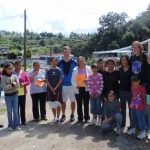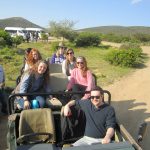 International Service Teams, formerly part of Community Service Programs, first began in 1989. Since that time, over 400 K-State students have lived and worked alongside communities in 22 different countries on five continents. While the program, partners, and students have changed over the years, the core has remained the same—that service is reciprocal, that our teams are going to learn from and with the community, and that the service projects are driven and determined by our site partners.
International Service Teams, formerly part of Community Service Programs, first began in 1989. Since that time, over 400 K-State students have lived and worked alongside communities in 22 different countries on five continents. While the program, partners, and students have changed over the years, the core has remained the same—that service is reciprocal, that our teams are going to learn from and with the community, and that the service projects are driven and determined by our site partners.
During the summer of 2017, 15 students spent time in Ocean View, South Africa; Cabarete, Dominican Republic; Kamba Cua, Paraguay; Kartong, The Gambia; and Nyeri, Kenya. Students were working on sustainable agriculture practices in western African, with schoolchildren at a summer camp in the Caribbean, and on a mentorship program in the highlands of Kenya. The most powerful notion of leadership that we know and believe at the Staley School is that leadership is a relationship. We are thankful to have partners who work for the betterment of their communities, and push our students’ understanding of leadership and service.
In the letter below, K-State alumnus and now member of the Peace Corps, Ronnie Sullivan, shares his reflections as a past participant and coordinator for International Service Teams:
 “As an eager freshman searching for my place in the world, I was both anxious and excited to serve in La Preciosita, Mexico for 10 weeks during my first summer break. Having been strongly interested in poverty alleviation and international development, International Service Teams appealed to me as an introduction to my potential career. I had no idea what I was getting myself into.
“As an eager freshman searching for my place in the world, I was both anxious and excited to serve in La Preciosita, Mexico for 10 weeks during my first summer break. Having been strongly interested in poverty alleviation and international development, International Service Teams appealed to me as an introduction to my potential career. I had no idea what I was getting myself into.
My two teammates and I were earnest in our efforts to support the community that welcomed us. Everyday we taught between 3 to 5 English classes to children ranging from 2 to 16 years old as well as the school’s English teachers, and adults in the community. We often taught more than 90 people a day – in Spanish – without prior experience teaching English. Needless to say I was surprised at how exhausted, homesick and uncomfortable I felt. I remember visiting with my teammates one day while I was getting over a stomach-bug; “Wow you guys, I always thought I could do development work abroad, but I don’t think I have what it takes. I would never do the Peace Corps.”
Fortunately, I was also surprised by: The hospitality and genuine love with which we were received by our host families. The friendships that we formed and continue to enjoy. The speed with which our 2-5 year old students learned the colors, or sang “eyes, ears, mouth and nose… head, shoulders, knees and toes, knees and toes!” Nor will I forget the first-hand perspective I gained regarding immigration and economic opportunities (or the lack thereof)…Oh, and also the tacos!
I find it ironic that I’m typing this in rural Paraguay – my sixth month into serving as a Community Economic Development Volunteer in the Peace Corps! My involvement with K-State’s International Service Teams did not end when I flew back from Mexico. In addition to the program’s semester-long course to prep its participants for a summer of service, cultural immersion, and critical thought, students also congregate after the summer to digest their experiences and think deeply about inequality, power, privilege, diversity, gender, culture, economic relationships and much more. My continued involvement in the Staley School of Leadership Studies and my eventual work as a Student Coordinator for the IST program provided numerous opportunities to examine the way our world is, and perhaps how it ought to be in terms of wealth distribution, personal agency and access to opportunities. By my December, 2016 graduation, I was able to confidently commit 27 months of my life to serving my future family and friends in Paraguay… I’m so glad that 19-year old Ronnie was wrong!
Some of the themes that have appeared in my work with community members include the following: Boy/Girl Scouts sustainability, Leadership skills, Community service and organizing, Improved market information, Women and Youth empowerment, English teaching, Entrepreneurship skills, Marketing skills.
However, development work is slow and rather ambiguous, so for a more robust explanation of my life in Paraguay, please visit my blog!
Looking back at my service in Mexico and involvement in IST, I’m grateful for the challenging nature of the experience. If the best place to learn is outside of our comfort zone, then I was left with plenty of knowledge to serve as the framework through which I have come to understand the world.” –Ronnie Sullivan
Supporting International Service Teams
As previously mentioned, IST has changed over the years. Unfortunately, due to changes in funding, students are now responsible for funding the cost of the program. The average summer costs about $3500, differing slightly from site to site. Not only are students baring the cost of their summer experience, but because they are away, the possibility of a paid summer job or internship to help fund their academic diminishes. As you can imagine, students’ ability (or inability) to pay greatly affects who is able to even apply for IST.
By supporting the “Leadership for Life” fund, you can help make this transformational experience possible for more students.
Though International Service Teams has been in existence for almost three decades, the Staley School is excitedly celebrating 20 years! We would love to see you at our 20th Anniversary Celebration and Reunion Weekend, November 10-12, to connect with current students and alumni of the Staley School!









